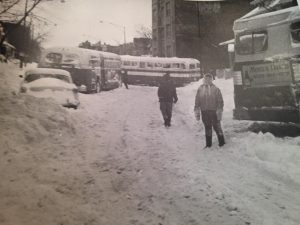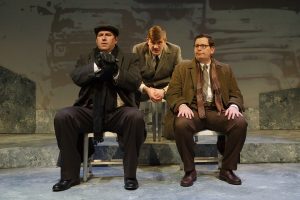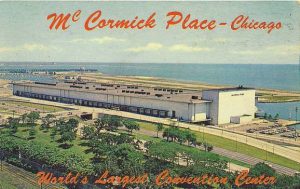50 years later: Monster blizzard of ’67 still stirs memories
By Jean Lotus Staff Reporter — January 23, 2017
Diane Callahan Mastny, 12, stands on Laramie Avenue near abandoned buses in Jan. 1967 (Photo courtesy Diane Mastny)
It was — and still is — a Chicago snowfall for the record books.
What Chicagoans of a certain age call the “Blizzard of ’67” wasn’t really, technically, a blizzard, but an extreme snow dump of 23 inches in 24 hours overnight, Jan. 26-27. The biggest snowfall in Chicago recorded history happened 50 years ago and paralyzed the city and suburbs for days.
People shared memories of that first “Snowpocalypse” at an open mic event Jan. 21 at Culver’s Restaurant in Berwyn.
The event was a fundraiser for Berwyn’s 16th Street Theater, which is performing the four-man drama “Blizzard ‘67” by playwright-in-residence Jon Steinhagen.
“My journey began and ended two days later in exactly the same place — Glenbrook South High School, Glenview, Ill.,” said Carol Hultgren Raia, who described herself as a “survivor.” Raia had dawdled after school at a friend’s home Thursday, Jan. 26 and her father and brother were sent out in the storm to fetch her.
“They arrived, I got in the car, and we attempted to drive home. After sliding all over and not being able to see, we made it back to the high school parking lot,” she said.
“To my amazement, there were other people there already. More and more people kept coming in (mostly men on their way home from work).”
After an unusually warm 65-degree Tuesday, Jan. 24, temperatures plunged below freezing. Light flakes began to fall in the early morning Thursday but by that evening, gusts of wind created 10-foot mounds of snow at Midway Airport. The storm created chaos Thursday night as commuters tried to escape Chicago. The Tribune reported more than 800 CTA buses and 20,000 automobiles were stranded on the streets and highways around Chicago. Almost two feet had fallen by Friday, when schools shut down. Cumbersome garbage trucks, equipped with snow blades, were used to plow Chicago streets. It took five days for the city and suburbs to dig out.
Raia and her family spent the night, “sitting in the auditorium chairs. It was freezing cold and all systems were shut down for the night. Someone had to break the lock on the kitchen doors to see what there was to eat. I remember egg salad and saltine crackers.”
Grocery stores were mobbed with milk and bread snatched from the shelves.
“I remember my father pulling a sled with milk, bread and eggs down the middle of the street,” said Holly Striska.
One enterprising neighbor used his new Polaris snowmobile to ferry businessmen to the Loop and back. “He made a fortune by transporting business people to work,” one participant said.
Local playwright Marilyn Campbell remembered a “Star Trek date” that turned into a snow-trek odyssey her freshman year at Michigan State University in East Lansing. Leaving a white convertible buried in the snow, she and her date slogged at “warp speed” back to the dorm where she faced a “demerit” for every minute she was late. According to fraternity custom, the next day Campbell received “24 roses, one for every minute I was late. My mother wept when we broke up.”
During the storm and the days that followed, Chicago’s neighborhoods reported looting. Twenty-six people died, including a 10-year-old girl who was caught in gunfire, according to the Tribune.
Possibly because Chicago has so few natural disasters like tornadoes, floods or hurricanes, or because it looms in the childhoods of so many baby boomers, the 1967 blizzard has a place in the collective memory.
Playwright Steinhagen, age 47, wasn’t even born in 1967, but he heard about the blizzard from his parents, and so many others, who remember neighbors helping each other.

Mark Pracht (from left), Christian Stokes and Noah Simon perform in “Blizzard ’67” at 16th Street Theater in Berwyn. (Photo by Anthony Aicardi)
Blizzard ’67, first performed in 2012 in Chicago, explores the way humans react to an unexpected emergency, he said. A carpool of four suburban businessmen, “make a foolhardy attempt to drive home from the Loop right smack in the middle of this blizzard,” Steinhagen said.
One man, resented for his success by the others, exits the car to help a stranded driver.
“The others think they hear gunshots and step on the gas, abandoning the guy in the snow,” he said. “I wanted to explore the theme of the debt we owe to each other — friends family and perfect strangers,” Steinhagen said.
Fran Sullivan, of Oak Park, remembered how she realized she was about to go into labor with her fourth child that Friday morning.
“It had actually stopped snowing, but the drifts were 40 inches high.” Her River Forest doctor was snowed in, unable to travel to St. Anne’s Hospital, where his own son was being cared for.
“Call the police and get to Oak Park Hospital,” he advised.
On the sidewalk, her husband helped her struggle into her boots and “fake fur coat” she said.
“I was sure everyone on the street was watching this drama.”
Trudging down the block, she was helped into waiting squad car.
“When the officer turned on the siren I was so unnerved, I thought, this is why people give birth in police cars.”
Her son, Patrick, “Blizzard Baby” Sullivan was born four hours later. Today, Patrick, an ice hockey and winter enthusiast, is up early with his own snowplow on winter days plowing his entire Oak Park block.
“It was a wonderful time, when neighbors looked out for each other,” Fran Sullivan said.

Playwright Marilyn Campbell shares her memories of the ’67 snowstorm at Culver’s in Berwyn. (Chronicle Media Photo)
Nostalgia flowed at the Culver’s open mic, which was also a fundraiser for the 16th Street’s 10th season.
“I got out of work at the mail-order house at Roosevelt and Cicero about 3 o’clock and my car was buried,” said Helen Clarke.
After a few drinks at the bar across the street, Campbell and her colleagues were able to uncover their cars with help from a maintenance worker.
“I finally was able to drive home, about 11 p.m. and around 38th and East I finally slid into a stop sign a block away from my house.”
Neighbors got together to socialize, she said.
“We walked over to Harlem and Ogden, to the White Castle. That was open.”
The city was still reeling from the Jan. 16 blaze that destroyed the first Chicago convention site, McCormick Center, the “long white box on the lakefront” built in 1960. Chicago firefighters struggling in the cold found hydrants were disconnected. The roof of the building collapsed; fire consumed exhibits for the annual Housewares Show and a janitor died.
On television, over the snow days, homebound Chicagoans learned the sad news of the death of three Apollo 1 astronauts, killed when a fire broke out in the capsule, during a launch rehearsal at Cape Kennedy.
But for children, the storm and the days of snow were magical. Open mic participants remembered walking across drifts on parked cars and sledding in the middle of the street.
“It was a 12-year-old’s dream,” said Diane Mastny, who grew up on the West Side of Chicago. “I got to go walking with my dad up and down streets where you couldn’t normally walk, like Laramie Avenue where huge CTA buses were just stranded and abandoned.”
“ I just remember the silence,” said Michael. The quiet snowscape was a contrast from the noise from the traffic and electric trolley buses near his home at 25th and Kedzie Avenue. “With the drifted snow on buses and cars it was like being on another planet. No traffic, no buses that were usually so noisy. It was so quiet and tranquil.”
“We were lucky guys growing up in Burbank, then unincorporated Cook County,” said Mike Katcher, a health inspector visiting the Culver’s, who jumped in to share his memories.
“We were always outside and we were always looking for snow.”
Ten friends spent the blizzard weekend climbing the high drifts to the roof of their school and jumping off.
“It was pretty awesome to jump down through the drifts,” he said.
A trip to the airport to go back to college was abandoned, said a woman named Jean. “My boyfriend, whom my father detested, offered to drive me to the airport,” she said. As the two abandoned the trip, she noticed snow-plowing garbage trucks with “the blades hanging sideways on the highway coming out of the airport,” she said. “I thought my father had been angry before, but when he found out I wasn’t getting home, he was furious,” she said.
Trapped with the boyfriend’s family for five days, she said the television weatherman looked more and more bedraggled as the storm wore on.
“I was snowbound with my boyfriend for five days and [at the end] we never wanted to see each other again.”
Blizzard ’67 is performed at 16th Street Theater in Berwyn until March 4. For more information visit www.16thstreettheater.org.
— 50 years later: Monster blizzard of ’67 still stirs memories —





